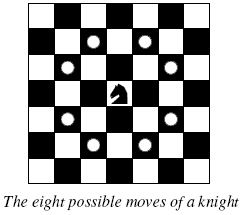A Knight's Journe
| Time Limit: 1000MS | Memory Limit: 65536K | |
| Total Submissions: 40970 | Accepted: 13938 |
Description
 Background
Background
The knight is getting bored of seeing the same black and white squares again and again and has decided to make a journey
around the world. Whenever a knight moves, it is two squares in one direction and one square perpendicular to this. The world of a knight is the chessboard he is living on. Our knight lives on a chessboard that has a smaller area than a regular 8 * 8 board, but it is still rectangular. Can you help this adventurous knight to make travel plans?
Problem
Find a path such that the knight visits every square once. The knight can start and end on any square of the board.
Input
The input begins with a positive integer n in the first line. The following lines contain n test cases. Each test case consists of a single line with two positive integers p and q, such that 1 <= p * q <= 26. This represents a p * q chessboard, where p describes how many different square numbers 1, . . . , p exist, q describes how many different square letters exist. These are the first q letters of the Latin alphabet: A, . . .
Output
The output for every scenario begins with a line containing "Scenario #i:", where i is the number of the scenario starting at 1. Then print a single line containing the lexicographically first path that visits all squares of the chessboard with knight moves followed by an empty line. The path should be given on a single line by concatenating the names of the visited squares. Each square name consists of a capital letter followed by a number.
If no such path exist, you should output impossible on a single line.
If no such path exist, you should output impossible on a single line.
Sample Input
3 1 1 2 3 4 3
Sample Output
Scenario #1: A1 Scenario #2: impossible Scenario #3: A1B3C1A2B4C2A3B1C3A4B2C4
注意马的跳动列数是按照字典序调的,也就是说必须按照A B C.....A B....这样
#include <iostream>
#include <cstdio>
#include <cstring>
using namespace std;
const int maxn = 30;
int vis[maxn][maxn];
int dir[8][2] = {{-2,-1},{-2,1},{-1,-2},{-1,2},{1,-2},{1,2},{2,-1},{2,1}};
int n,m,flag;
struct Path{
int x,y;
}p[maxn];
void dfs(int x,int y,int step){
if(flag)
return;
p[step].x=x;
p[step].y=y;
if(step==n*m)
{
flag = 1;
return ;
}
Path next;
for(int i = 0;i<8;i++)
{
next.x = x+dir[i][0];
next.y = y+dir[i][1];
if(next.x >=1&&next.x<=m&&next.y>=1&&next.y<=n&&!vis[next.x][next.y])
{
vis[next.x][next.y]=1;
dfs(next.x,next.y,step+1);
vis[next.x][next.y]=0;
}
}
return ;
}
int main()
{
int T;
cin>>T;
for(int t = 1;t<=T;t++){
cin>>n>>m; //输入行数和列数,行数是y的边界,列数是x的边界
memset(vis,0,sizeof(vis));
memset(p,0,sizeof(p));
flag=0;
vis[1][1]=1;
dfs(1,1,1);
printf("Scenario #%d:\n", t);
if(flag){
for(int i = 1;i<=n*m;i++)
printf("%c%d",p[i].x-1+'A',p[i].y);
cout<<endl;
}
else cout<<"impossible"<<endl;
if(t!=T) cout<<endl;
}
return 0;
}
 注意模拟的是二维数组的坐标,不要和数学坐标弄淆。
注意模拟的是二维数组的坐标,不要和数学坐标弄淆。
























 534
534

 被折叠的 条评论
为什么被折叠?
被折叠的 条评论
为什么被折叠?








